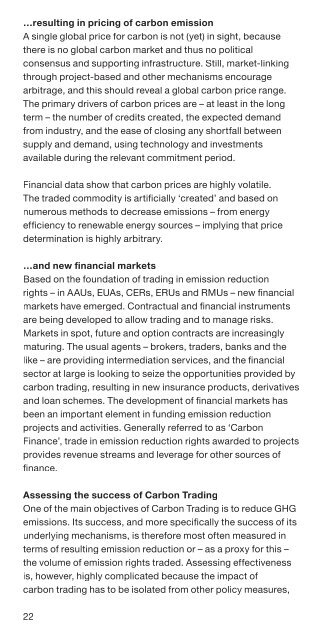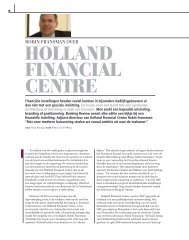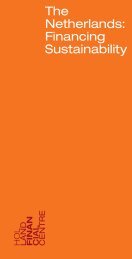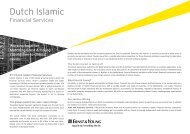download the full PDF document - Holland Financial Centre
download the full PDF document - Holland Financial Centre
download the full PDF document - Holland Financial Centre
You also want an ePaper? Increase the reach of your titles
YUMPU automatically turns print PDFs into web optimized ePapers that Google loves.
…resulting in pricing of carbon emissionA single global price for carbon is not (yet) in sight, because<strong>the</strong>re is no global carbon market and thus no politicalconsensus and supporting infrastructure. Still, market-linkingthrough project-based and o<strong>the</strong>r mechanisms encouragearbitrage, and this should reveal a global carbon price range.The primary drivers of carbon prices are – at least in <strong>the</strong> longterm – <strong>the</strong> number of credits created, <strong>the</strong> expected demandfrom industry, and <strong>the</strong> ease of closing any shortfall betweensupply and demand, using technology and investmentsavailable during <strong>the</strong> relevant commitment period.<strong>Financial</strong> data show that carbon prices are highly volatile.The traded commodity is artifi cially ‘created’ and based onnumerous methods to decrease emissions – from energyeffi ciency to renewable energy sources – implying that pricedetermination is highly arbitrary.…and new financial marketsBased on <strong>the</strong> foundation of trading in emission reductionrights – in AAUs, EUAs, CERs, ERUs and RMUs – new fi nancialmarkets have emerged. Contractual and fi nancial instrumentsare being developed to allow trading and to manage risks.Markets in spot, future and option contracts are increasinglymaturing. The usual agents – brokers, traders, banks and <strong>the</strong>like – are providing intermediation services, and <strong>the</strong> fi nancialsector at large is looking to seize <strong>the</strong> opportunities provided bycarbon trading, resulting in new insurance products, derivativesand loan schemes. The development of fi nancial markets hasbeen an important element in funding emission reductionprojects and activities. Generally referred to as ‘CarbonFinance’, trade in emission reduction rights awarded to projectsprovides revenue streams and leverage for o<strong>the</strong>r sources offi n a n c e .Assessing <strong>the</strong> success of Carbon TradingOne of <strong>the</strong> main objectives of Carbon Trading is to reduce GHGemissions. Its success, and more specifi cally <strong>the</strong> success of itsunderlying mechanisms, is <strong>the</strong>refore most often measured interms of resulting emission reduction or – as a proxy for this –<strong>the</strong> volume of emission rights traded. Assessing effectivenessis, however, highly complicated because <strong>the</strong> impact ofcarbon trading has to be isolated from o<strong>the</strong>r policy measures,22
















